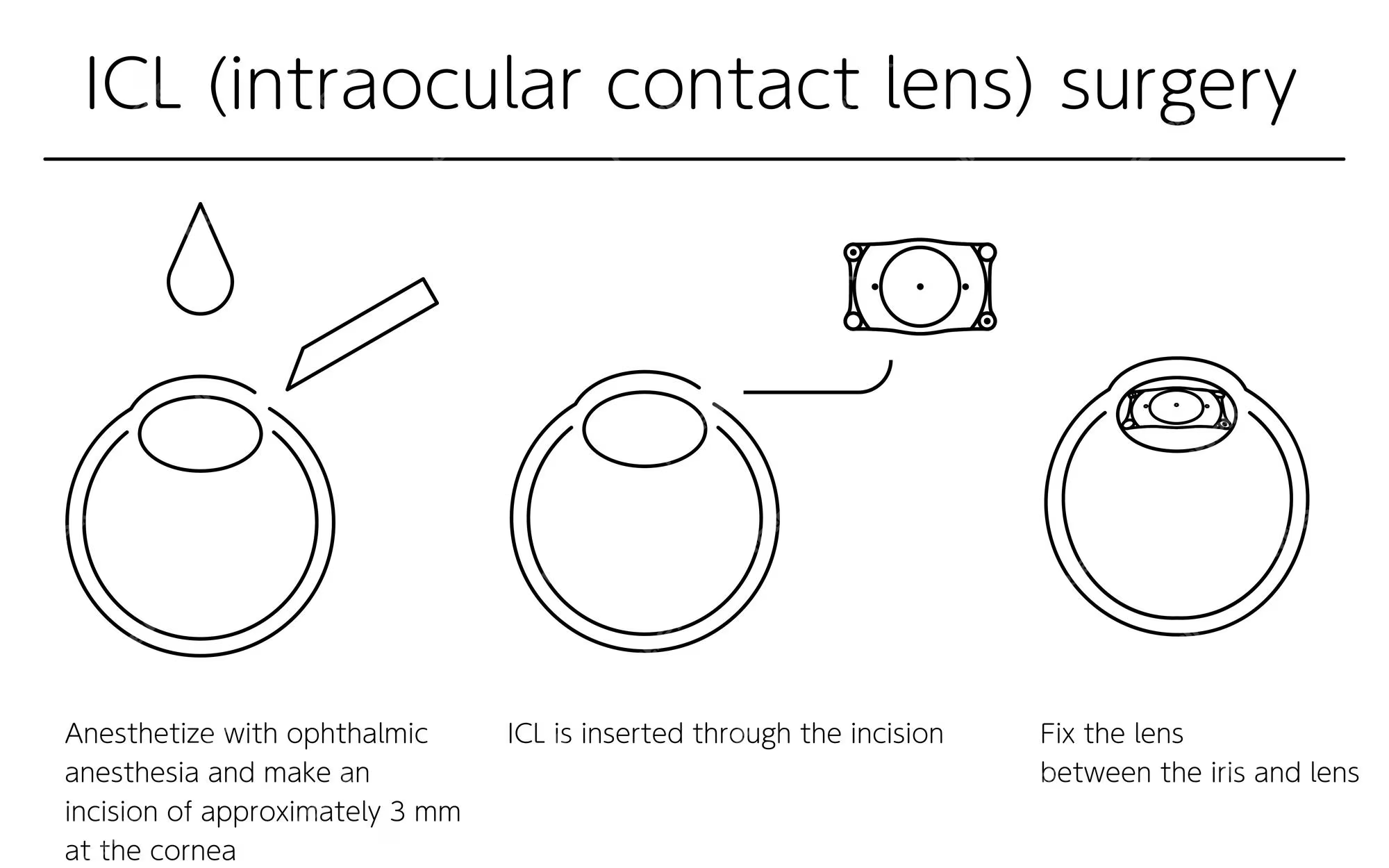Updated on October 10, 2024
ICL Surgery: What to Expect and More


Vision Center is funded by our readers. We may earn commissions if you purchase something via one of our links.
Implantable collamer lens (ICL) surgery (also known as Visian ICL surgery) is a popular eye surgical procedure that helps correct vision. It addresses myopia (shortsightedness) and astigmatism (irregularly shaped cornea).
People who wear glasses or contact lenses can benefit from ICL surgery. Studies show that over 94% of people undergoing ICL surgery achieve 20/40 vision without contact lenses or eyeglasses.3
How Does ICL Surgery Work?
ICL surgery involves placing a soft plastic and collagen-based lens (ICL) between the iris and the eye's natural lens. They’re like permanent contact lenses that help focus light on the retina.

Implantable contact lenses resemble intraocular lenses (IOLs) used in cataract surgery. They’re a type of phakic intraocular lenses.2 Phakic refers to placing artificial lenses without removing the eye’s existing lens.

ICL is a great alternative to LASIK eye surgery in people with severe nearsightedness. It offers a permanent solution to vision issues. The process is also reversible through lens removal.
Benefits of ICL Surgery
Here are some of the top benefits of ICL surgery:
High-Quality Vision Correction
One of the main benefits of ICL eye surgery is that it offers high-quality vision correction. People who undergo this treatment achieve their desired clear vision. The success rate of ICL surgery is almost similar to LASIK eye surgery.
Quick Recovery
ICL eye surgery doesn’t require any downtime. You can go home after the treatment. However, following your eye doctor’s aftercare results is crucial to avoid any possible complications.
Stable and Predictable Results
Results from ICL surgery are usually stable. Once the surgeon implants the lens in your eye, you can expect steady results afterward.
Reversible Option
ICL eye surgery is a reversible treatment. Unlike LASIK, you can remove or replace the implanted lenses. This is a good option for people unsure about a long-term commitment to the surgical procedure.
Corneal Preservation
ICL is a refractive surgery that doesn’t involve creating a corneal flap. The lens is implanted using a microscopic incision that requires no stitches. This leads to fewer corneal complications and preservation of the corneal structure.
Side Effects and Risks of ICL Surgery
Like other eye procedures, ICL surgery has different side effects and risks.
Side effects of ICL surgery include:
- Mild pain
- Blurry vision
- Dry eyes
- Red eyes
- Gritty eyes
- Double vision
- Halos, glares, and starbursts
- Increased eye pressure (Glaucoma)
- Light sensitivity
- Early cataracts (cloudy cornea)
In most cases, the ICL procedure will go smoothly. However, there are a few possible complications, including:6
- Overcorrection or under-correction
- Retinal detachment
- Excessive bleeding
- Eye infections (rare but serious)
- Vision loss
Ideal Candidates for ICL Surgery
Implantable contact lens surgery isn't safe for everyone. A good candidate for ICL surgery has the following characteristics:
- Between 21 and 45 years old
- In good general health
- Meets the minimum endothelial cell density for their age
- Not a good LASIK surgery candidate
- Has moderate to severe myopia (-3 diopters to -20 diopters)
- Has minor to no astigmatism
- Has good eye health
- Does not take medications that can interfere with surgery or healing
- Has at least 6 months to a year of unchanged vision correction prescriptions
- Is not pregnant or breastfeeding
- Is not allergic to local anesthesia
How Much Does ICL Surgery Cost?
Generally, expect to pay about $4,000 to $5,000 per eye. However, this cost will vary and can be higher depending on various factors.
These factors include:
- Location of the surgery center
- Level of technology used in the surgery
- Other additional services included in the surgery package
Some surgeons may provide an all-inclusive package that includes the surgery, anesthetic, pre- and post-operative care, and other related services. The cost could be higher than $5,000 per eye in this case.
Does Insurance Cover ICL?
Visian ICL is considered elective surgery and is unlikely to be covered by your insurance. The cost may also vary from one surgeon to the other.
Remember to ask your surgeon and insurance provider about insurance coverage.
ICL Surgery: What to Expect
ICL surgery is an outpatient procedure, meaning you'll go home the same day. Below is what to expect before, during, and after surgery.
Preparing for Surgery
Here’s what to expect before ICL surgery:
YAG Laser Iridotomy
Your doctor will perform a YAG laser iridotomy about 2 weeks before surgery.4 This procedure involves creating tiny holes in the front chamber of your eyes to allow proper flow of the aqueous humor. Iridotomy prevents pressure buildup after surgery.
Comprehensive Eye Exam
Your eye doctor will perform a comprehensive eye exam a week before the procedure. The exam will help ensure your eyes are healthy and suitable for the procedure. You'll also undergo pupil and corneal evaluation and endothelial cell count.5
Additional Preparations
If you wear contact lenses, your ophthalmologist will advise not wearing them for several days to weeks before the surgery. This will allow your eyes to return to normal.
Tell your doctor about any medications you're taking and any previous surgeries, underlying medical conditions, or allergies you have or have had. Also, inquire whether you can drink or eat before surgery.
Lastly, prepare reliable transportation both to and from surgery. You won’t be able to drive after eye surgery, as you may have distorted vision.
Procedure Steps
Once you arrive at your doctor's office, you'll sit on a reclining chair, and the doctor will prepare your eyes. The procedure will be as follows:
- The surgeon will first administer dilating eye drops to enlarge your pupils.
- After, they'll apply a topical anesthetic to prevent pain and discomfort during surgery. They may also use a sedative to help you relax.
- Your surgeon will then clean the eye and surrounding areas. They'll hold your eyes open using a speculum, preparing them for surgery.
- The surgery will involve an incision in the cornea and the placement of a tiny ICL between the iris and the eye's natural lens.
- Once the lens is in place, the surgeon will close the incision with small stitches.
- The surgeon will then apply antibiotics and topical steroids to prevent infection and inflammation.
- The surgeon may also apply a patch or eyeshield for protection and comfort.
The entire procedure takes about 30 minutes. You may need a few hours in the recovery room for close monitoring before discharge.
Aftercare & Recovery
After surgery, your doctor will prescribe antibiotics and other ointments to ease pain and discomfort. They'll also provide post-op care instructions to follow.
You must make a follow-up appointment a day after surgery for close monitoring.
General care instructions after ICL surgery include:
- Avoid rubbing your eyes 3 to 5 days after surgery
- Take medication as prescribed
- Rest your eyes
- Avoid strenuous activities such as weightlifting, contact sports, etc.
Following your surgeon's instructions and attending regular follow-up appointments will allow proper wound healing. Ask your doctor before resuming driving, contact sports, or any other strenuous activity.
You’ll notice improved vision within 2 to 3 days. Expect full recovery after 3 to 4 weeks. Call your doctor if you experience severe eye pain or notice sudden vision changes, which may signal a complication.
Alternative Treatment Options
The severity of your nearsightedness determines the type of treatment appropriate for you. Alternative treatment options include:
Laser-Assisted In Situ Keratomileusis (LASIK)
Laser-assisted in situ keratomileusis (LASIK) is the most popular refractive surgery. It involves creating a flap on the cornea and reshaping it using laser technology. This improves visual acuity.
LASIK corrects:
- Myopia
- Hyperopia
- Astigmatism
- Presbyopia (age-related farsightedness)
There are also different types of LASIK, such as LASEK, Epi-LASIK, and iLASIK.
Photorefractive Keratectomy (PRK)
Unlike LASIK, PRK doesn’t require flap formation to reshape the cornea. It's a good alternative for people with a thin cornea and, therefore, don't qualify for LASIK.
PRK involves the removal of the corneal epithelium (thin top layer of the cornea) to allow for laser treatment.
Small Incision Lenticule Extraction (SMILE)
SMILE is a laser-based refractive surgery. The surgeon uses a femtosecond laser to cut out a piece of the cornea known as a lenticule. They make an incision to remove the lenticule, which changes the shape of the cornea to achieve better vision.
Conductive Keratoplasty (CK)
Conductive keratoplasty (CK) uses radiofrequency energy to reshape irregular corneas. It treats low hyperopia with or without astigmatism and presbyopia (age-related farsightedness). CK also treats residual refractive errors after cataract surgery or LASIK.7
Summary
- ICL eye surgery is a safe and effective treatment option for correcting vision.
- It offers various benefits that can't be found with other refractive surgery options.
- However, it's important to understand the possible side effects and risks of ICL before undergoing the procedure.
- Always consult your eye doctor for more information about the various types of refractive surgery available for vision correction.
In this article
7 sources cited
Updated on October 10, 2024
Updated on October 10, 2024
About Our Contributors
Vincent Ayaga is a medical researcher and seasoned content writer with a bachelor's degree in Medical Microbiology. Specializing in disease investigation, prevention, and control, Vincent is dedicated to raising awareness about visual problems and the latest evidence-based solutions in ophthalmology. He strongly believes in the transformative power of ophthalmic education through research to inform and educate those seeking knowledge in eye health.
Dr. Melody Huang is an optometrist and freelance health writer with a passion for educating people about eye health. With her unique blend of clinical expertise and writing skills, Dr. Huang seeks to guide individuals towards healthier and happier lives. Her interests extend to Eastern medicine and integrative healthcare approaches. Outside of work, she enjoys exploring new skincare products, experimenting with food recipes, and spending time with her adopted cats.

